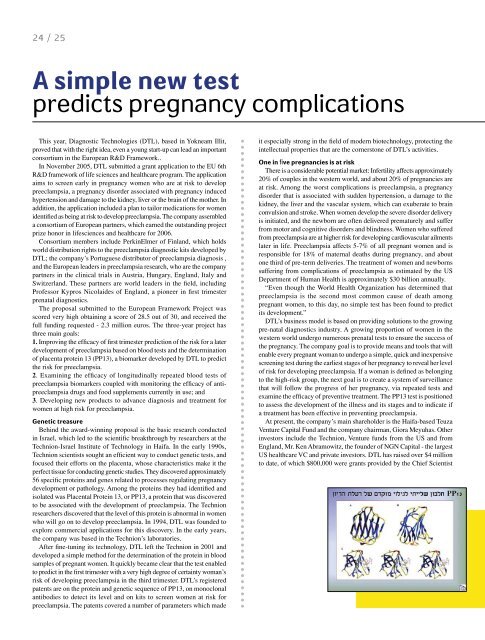Télécharger le document - Eurosfaire
Télécharger le document - Eurosfaire
Télécharger le document - Eurosfaire
You also want an ePaper? Increase the reach of your titles
YUMPU automatically turns print PDFs into web optimized ePapers that Google loves.
24 / 25<br />
A simp<strong>le</strong> new test<br />
predicts pregnancy complications<br />
This year, Diagnostic Technologies (DTL), based in Yokneam Illit,<br />
proved that with the right idea, even a young start-up can <strong>le</strong>ad an important<br />
consortium in the European R&D Framework..<br />
In November 2005, DTL submitted a grant application to the EU 6th<br />
R&D framework of life sciences and healthcare program. The application<br />
aims to screen early in pregnancy women who are at risk to develop<br />
preeclampsia, a pregnancy disorder associated with pregnancy induced<br />
hypertension and damage to the kidney, liver or the brain of the mother. In<br />
addition, the application included a plan to tailor medications for women<br />
identified as being at risk to develop preeclampsia. The company assemb<strong>le</strong>d<br />
a consortium of European partners, which earned the outstanding project<br />
prize honor in lifesciences and healthcare for 2006.<br />
Consortium members include PerkinElmer of Finland, which holds<br />
world distribution rights to the preeclampsia diagnostic kits developed by<br />
DTL; the company’s Portuguese distributor of preeclampsia diagnosis ,<br />
and the European <strong>le</strong>aders in preeclampsia research, who are the company<br />
partners in the clinical trials in Austria, Hungary, England, Italy and<br />
Switzerland. These partners are world <strong>le</strong>aders in the field, including<br />
Professor Kypros Nicolaides of England, a pioneer in first trimester<br />
prenatal diagnostics.<br />
The proposal submitted to the European Framework Project was<br />
scored very high obtaining a score of 28.5 out of 30, and received the<br />
full funding requested - 2.3 million euros. The three-year project has<br />
three main goals:<br />
1. Improving the efficacy of first trimester prediction of the risk for a later<br />
development of preeclampsia based on blood tests and the determination<br />
of placenta protein 13 (PP13), a biomarker developed by DTL to predict<br />
the risk for preeclampsia.<br />
2. Examining the efficacy of longitudinally repeated blood tests of<br />
preeclampsia biomarkers coup<strong>le</strong>d with monitoring the efficacy of antipreeclampsia<br />
drugs and food supp<strong>le</strong>ments currently in use; and<br />
3. Developing new products to advance diagnosis and treatment for<br />
women at high risk for preeclampsia.<br />
Genetic treasure<br />
Behind the award-winning proposal is the basic research conducted<br />
in Israel, which <strong>le</strong>d to the scientific breakthrough by researchers at the<br />
Technion-Israel Institute of Technology in Haifa. In the early 1990s,<br />
Technion scientists sought an efficient way to conduct genetic tests, and<br />
focused their efforts on the placenta, whose characteristics make it the<br />
perfect tissue for conducting genetic studies. They discovered approximately<br />
56 specific proteins and genes related to processes regulating pregnancy<br />
development or pathology. Among the proteins they had identified and<br />
isolated was Placental Protein 13, or PP13, a protein that was discovered<br />
to be associated with the development of preeclampsia. The Technion<br />
researchers discovered that the <strong>le</strong>vel of this protein is abnormal in women<br />
who will go on to develop preeclampsia. In 1994, DTL was founded to<br />
explore commercial applications for this discovery. In the early years,<br />
the company was based in the Technion’s laboratories.<br />
After fine-tuning its technology, DTL <strong>le</strong>ft the Technion in 2001 and<br />
developed a simp<strong>le</strong> method for the determination of the protein in blood<br />
samp<strong>le</strong>s of pregnant women. It quickly became c<strong>le</strong>ar that the test enab<strong>le</strong>d<br />
to predict in the first trimester with a very high degree of certainty woman’s<br />
risk of developing preeclampsia in the third trimester. DTL’s registered<br />
patents are on the protein and genetic sequence of PP13, on monoclonal<br />
antibodies to detect its <strong>le</strong>vel and on kits to screen women at risk for<br />
preeclampsia. The patents covered a number of parameters which made<br />
it especially strong in the field of modern biotechnology, protecting the<br />
intel<strong>le</strong>ctual properties that are the cornerstone of DTL’s activities.<br />
One in five pregnancies is at risk<br />
There is a considerab<strong>le</strong> potential market: Infertility affects approximately<br />
20% of coup<strong>le</strong>s in the western world, and about 20% of pregnancies are<br />
at risk. Among the worst complications is preeclampsia, a pregnancy<br />
disorder that is associated with sudden hypertension, a damage to the<br />
kidney, the liver and the vascular system, which can exuberate to brain<br />
convulsion and stroke. When women develop the severe disorder delivery<br />
is initiated, and the newborn are often delivered prematurely and suffer<br />
from motor and cognitive disorders and blindness. Women who suffered<br />
from preeclampsia are at higher risk for developing cardiovascular ailments<br />
later in life. Preeclampsia affects 5-7% of all pregnant women and is<br />
responsib<strong>le</strong> for 18% of maternal deaths during pregnancy, and about<br />
one third of pre-term deliveries. The treatment of women and newborns<br />
suffering from complications of preeclampsia as estimated by the US<br />
Department of Human Health is approximately $30 billion annually.<br />
“Even though the World Health Organization has determined that<br />
preeclampsia is the second most common cause of death among<br />
pregnant women, to this day, no simp<strong>le</strong> test has been found to predict<br />
its development.”<br />
DTL’s business model is based on providing solutions to the growing<br />
pre-natal diagnostics industry. A growing proportion of women in the<br />
western world undergo numerous prenatal tests to ensure the success of<br />
the pregnancy. The company goal is to provide means and tools that will<br />
enab<strong>le</strong> every pregnant woman to undergo a simp<strong>le</strong>, quick and inexpensive<br />
screening test during the earliest stages of her pregnancy to reveal her <strong>le</strong>vel<br />
of risk for developing preeclampsia. If a woman is defined as belonging<br />
to the high-risk group, the next goal is to create a system of surveillance<br />
that will follow the progress of her pregnancy, via repeated tests and<br />
examine the efficacy of preventive treatment. The PP13 test is positioned<br />
to assess the development of the illness and its stages and to indicate if<br />
a treatment has been effective in preventing preeclampsia.<br />
At present, the company’s main shareholder is the Haifa-based Teuza<br />
Venture Capital Fund and the company chairman, Giora Meyuhas. Other<br />
investors include the Technion, Venture funds from the US and from<br />
England, Mr. Ken Abramowitz, the founder of NGN Capital - the largest<br />
US healthcare VC and private investors. DTL has raised over $4 million<br />
to date, of which $800,000 were grants provided by the Chief Scientist

















